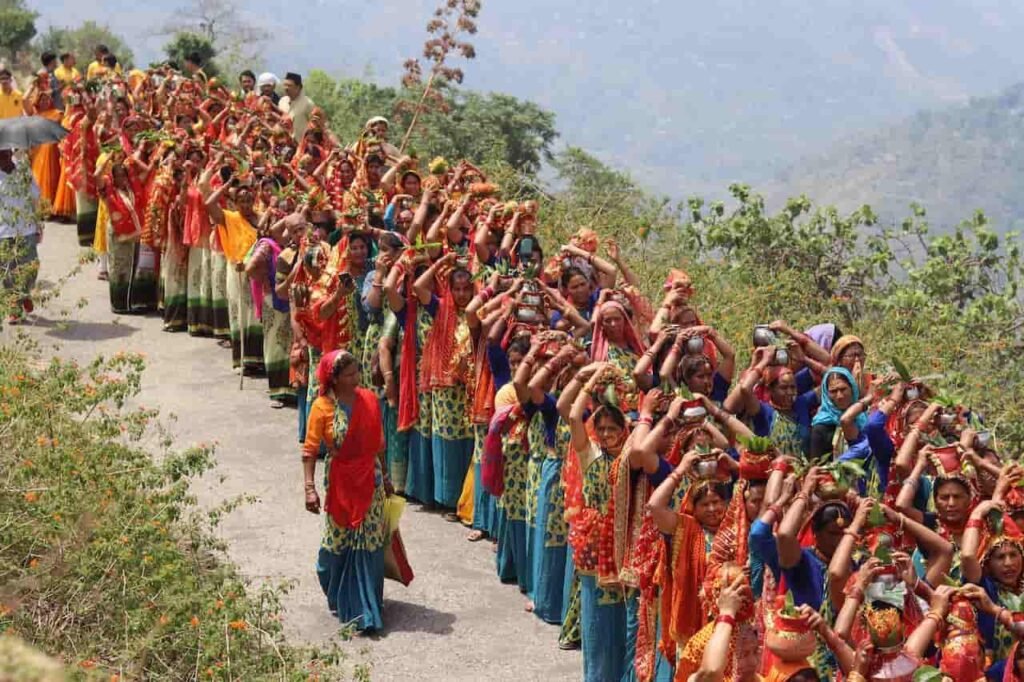
Kumaon is a region in the state of Uttarakhand, India, that is known for its rich cultural heritage, scenic beauty, and diverse flora and fauna. The people of Kumaon celebrate various festivals throughout the year that reflect their traditions, beliefs, and values. Some of the most popular Kumaoni festivals are:
- Harela: This Kumaoni festival is celebrated twice a year, once in the month of Chaitra (March-April) and once in the month of Shravan (July-August). Harela means “green leaves” and it symbolizes the arrival of the rainy season, the new harvest, and the wedding anniversary of Lord Shiva and Parvati. On this occasion, people sow seven types of grains in baskets filled with soil and water them daily. After ten days, the sprouted leaves are cut and distributed among relatives and friends as a token of good luck and prosperity. People also make clay idols of Lord Shiva, Parvati, Ganesh, and other deities and worship them. Harela is also followed by Bhitauli, a tradition of sending gifts to one’s sisters and daughters. To know more about Harela, you can read this article on our website: Harela: A Celebration of Nature and Culture in Uttarakhand.
- Kumaoni Holi: This festival is celebrated for a week in the month of Phalgun (February-March) with great enthusiasm and joy. Kumaoni Holi is unique in its musical aspect, as people sing songs based on classical ragas to the accompaniment of dholak (drum) and majeera (cymbals). There are three types of Kumaoni Holi: Baithki Holi, Khari Holi, and Mahila Holi. Baithki Holi is sung in temples or courtyards by professional singers called Holiyars. Khari Holi is sung by groups of men dressed in white who dance in the streets or fields. Mahila Holi is sung by women who gather at each other’s houses or public places. The songs of Kumaoni Holi have a touch of melody, fun, and spirituality. You can also watch some videos of Kumaoni Holi on YouTube.
- Sankranti(s): These are festivals that mark the transition of the sun from one constellation to another. Each Sankranti has a fair or festival associated with it somewhere in Kumaon. Some of the prominent Sankrantis are:
| Sankranti | Month | Festival |
|---|---|---|
| Phool Dei | Chaitra | People throw flowers at each other |
| Bikhauti | Vaishakh | People exchange gifts and visit temples |
| Ghee | Ashadh | People offer ghee (clarified butter) to Lord Shiva |
| Khatarua | Ashwin | People light bonfires and offer cucumbers to cows |
| Uttaraini | Paush | People take holy dips in rivers and visit fairs |
- Phool Dei: This Kumaoni festival is celebrated on the first day of the Hindu month Chaitra (March-April) as a harvest festival and a welcome to the spring season. Young girls are the main participants of this festival, as they pluck the first flowers of the season and scatter them on the doorsteps of their homes and other houses in their village or town. They also carry plates full of rice, jaggery, coconut, green leaves, and flowers to every house they visit and wish for their well-being and prosperity. They sing a song that goes like this: “Phool Dei, Chamma Dei, Deno Dwar, Bhur Bhakar, Vo Dei Sei Namashkar, Puje Dwar.” In return, they receive blessings, sweets, jaggery, and money from the households. Phool Dei is also a time for folk music and dance. You can also read more about Phool Dei on eUttaranchal.
- Bhitauli: This festival is celebrated in the month of Chaitra (March-April) after Harela by brothers who send gifts to their sisters and parents who send gifts to their daughters. The gifts may include clothes, jewellery, money, or food items. Bhitauli is a way of expressing love and affection to one’s female relatives.
Pingback: How Uttarakhand Celebrates Rakshabandhan: A Journey Through the Legends and Lore of the Land of Gods - Daaju Pahadi
Pingback: Khatarwa Festival: Celebrating the Arrival of Autumn and the Protection of Cattle - Daaju Pahadi
Pingback: How Uttarakhandi Pandits Celebrate Two Festivals in One Day - Daaju Pahadi